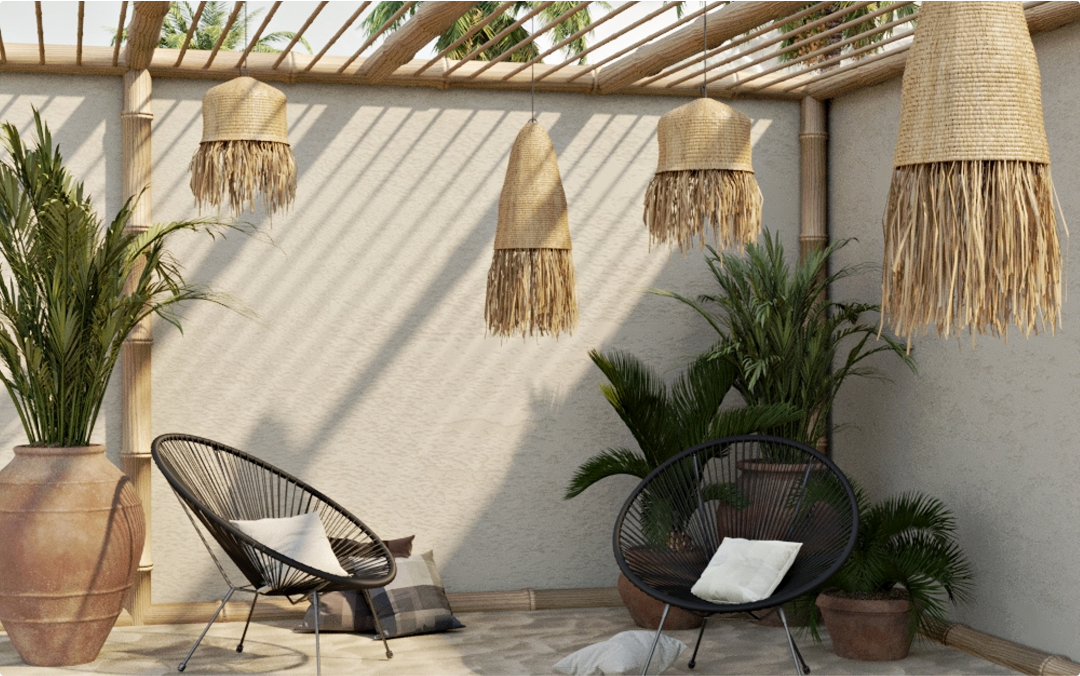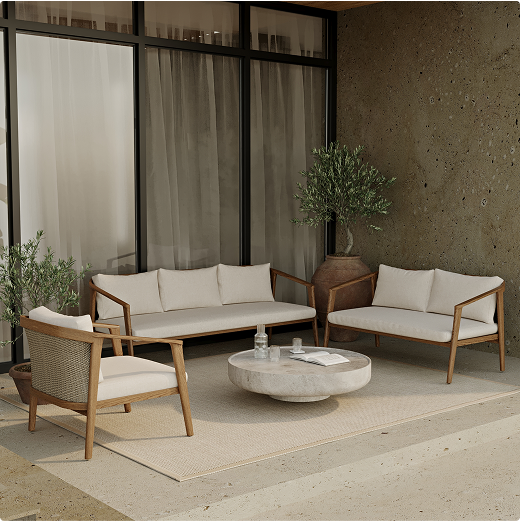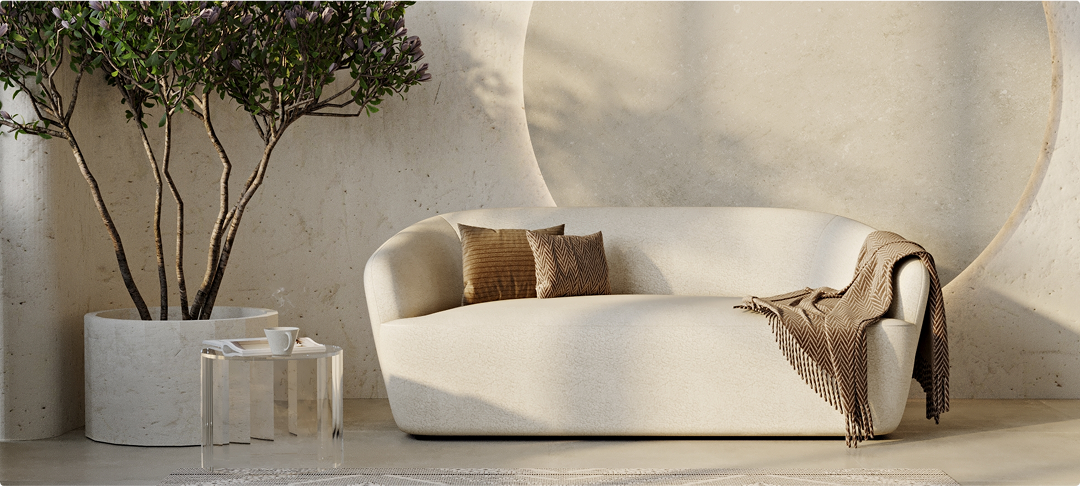Color and Light Psychology: The Basis for Decorating Your Small Apartment
Before moving a single piece of furniture, we must master the two most powerful elements of design: light and color. These are the brushes with which we paint the sense of spaciousness. It's not just about "painting white"; it's about understanding how these elements interact to trick the eye and calm the mind in a small space.
Expanding colors: The ideal palette for a small apartment
Color doesn't add anything to objects, but it takes up a huge amount of visual space. A poor choice can make a room feel suffocating, a mistake to avoid when decorating a small apartment.
- Sophisticated Monochromaticism: Instead of splashing different colors throughout, choose a main color (preferably light and neutral, such as off-white, pearl gray, or sandy beige) and use it in different shades and textures. Walls, large furniture, and textiles in the same color scheme create visual continuity that eliminates "intersections" and makes the space flow seamlessly.
- The 60-30-10 Rule (Compact Version): In a small apartment, adapt this classic rule. Use your dominant (neutral) color in 70% of the space (walls, sofa). 20% for a slightly bolder secondary color (pillows, an armchair, a rug). And reserve 10% for a vibrant accent (a piece of art, a vase, a design book) that acts as a focal point and adds personality without overwhelming.
- The ceiling, the great forgotten: Paint the ceiling pure white or a shade slightly lighter than the walls. This simple trick visually elevates the room, creating an instant sense of spaciousness.

Master the light: Your most powerful ally in a small apartment
Light is the chief sculptor of your home. Where there is light, there is a perception of space.
- Unobstructed natural light: Get rid of heavy, opaque curtains. Opt for sheer curtains, linen blinds, or Venetian blinds that provide privacy but allow light to filter through and bathe every corner. Natural light is the most effective and economical space expander available.
- Layered Lighting: Don't settle for just one ceiling light. To masterfully decorate a small apartment , you need to orchestrate the lighting.
- Ambient layer: General light (ceiling lamps, ceiling lights).
- Task Layer: Functional light for specific activities (a floor lamp next to the couch for reading, lights under kitchen cabinets).
- Accent layer: Directed light to highlight elements (a spotlight on a painting, a small lamp on a shelf).
This strategy creates depth, eliminates harsh shadows, and allows you to adapt the ambiance of the room depending on the time of day.

Furniture for small apartments: Think vertically and empty
Furniture is where most people make the fatal mistake: choosing pieces that are too large, heavy, and dark. The key to choosing furniture for a small apartment is lightness, both functional and visual.
Multifunctional furniture: The hero when decorating small spaces
Each piece must earn its place. If a piece of furniture only has one function, it's wasting valuable potential.
- Practical example: Instead of a massive coffee table, consider a set of two nesting tables. You can use them together, separate them when you have guests, or tuck the small one under the large one to clear the space. Or better yet, a lidded ottoman that doubles as extra seating, a footrest, and a secret storage chest for blankets and remote controls.

The power of negative space: Furniture that "floats"
The space you don't see is just as important as the space you do see. It allows your eyes to travel under and around furniture. This principle is vital when decorating small apartments.
- Elevate your furniture: Choose sofas, sideboards, console tables, and nightstands with tall, slender legs. By allowing a view of the floor below, it creates an illusion of more space and lightness. A sturdy sofa that reaches all the way to the floor cuts through the space, while a raised one appears to float above it.
- Wall-mounted: Consider floating shelves instead of free-standing bookcases. A desk or TV stand anchored to the wall completely frees up floor space, creating a spectacular sense of spaciousness
Furniture that doesn't block your view is your best friend. They're phantom objects: they fulfill their purpose without taking up visual space.
- Detailed example: Imagine a dining nook. A sturdy wooden table and four upholstered chairs would make it feel cramped. Now, replace them with a glass-topped table with slim metal legs and clear polycarbonate chairs (like the famous "Ghost" design). The nook is still functional, but visually it appears almost empty.

Smart Layout: How to Organize Flow in a Small Apartment
The way you arrange your furniture defines the experience of living in your apartment. A poor layout creates friction and constricts the space; a good layout, on the other hand, is key to successfully decorating a small apartment .
Zoning without walls: Define spaces in your small home
In a study or open-plan living-dining room, creating virtual "rooms" is crucial.
- The rug as a boundary: A well-sized rug in the living area brings together the sofa, coffee table, and armchair, creating a welcoming and defined "island." The space outside the rug is perceived as a passageway or a separate area.
- Furniture as subtle dividers: Place a low, open shelving unit (an étagère) or the back of your sofa to separate the living room from the dining room. This creates a functional divider without creating a wall that blocks light and the view.

The art of circulation: Create flowing paths in your apartment
You should be able to move around your home without having to avoid obstacles. Before deciding on a layout, walk through it. Is the path from the door to the sofa direct? Can you fully open the drawers and cabinet doors? These invisible paths should ideally be about 75-90 cm wide so you don't feel boxed in.

Illusionist Tricks: Finishing Touches for Decorating Your Small Apartment
This is where the magic really happens. These are the finishing touches that cement the feeling of spaciousness and sophistication.
The vertigo effect: Curtains from ceiling to floor
This is one of the most effective tricks for decorating a small apartment. Hang the curtain rod as close to the ceiling as possible and extend it about 15-20 cm on each side of the window. Let the curtains fall to just touch the floor. This simple and elegant gesture draws the eye upward, creating a powerful illusion of height.

Multifunctional furniture: The hero when decorating small spaces
Each piece must earn its place. If a piece of furniture only has one function, it's wasting valuable potential.
- Practical example: Instead of a massive coffee table, consider a set of two nesting tables. You can use them together, separate them when you have guests, or tuck the small one under the large one to clear the space. Or better yet, a lidded ottoman that doubles as extra seating, a footrest, and a secret storage chest for blankets and remote controls.

The power of negative space: Furniture that "floats"
The space you don't see is just as important as the space you do see. It allows your eyes to travel under and around furniture. This principle is vital when decorating small apartments.
- Elevate your furniture: Choose sofas, sideboards, console tables, and nightstands with tall, slender legs. By allowing a view of the floor below, it creates an illusion of more space and lightness. A sturdy sofa that reaches all the way to the floor cuts through the space, while a raised one appears to float above it.
- Wall-mounted: Consider floating shelves instead of free-standing bookcases. A desk or TV stand anchored to the wall completely frees up floor space, creating a spectacular sense of spaciousness
Furniture that doesn't block your view is your best friend. They're phantom objects: they fulfill their purpose without taking up visual space.
- Detailed example: Imagine a dining nook. A sturdy wooden table and four upholstered chairs would make it feel cramped. Now, replace them with a glass-topped table with slim metal legs and clear polycarbonate chairs (like the famous "Ghost" design). The nook is still functional, but visually it appears almost empty.

Smart Layout: How to Organize Flow in a Small Apartment
The way you arrange your furniture defines the experience of living in your apartment. A poor layout creates friction and constricts the space; a good layout, on the other hand, is key to successfully decorating a small apartment .
Zoning without walls: Define spaces in your small home
In a study or open-plan living-dining room, creating virtual "rooms" is crucial.
- The rug as a boundary: A well-sized rug in the living area brings together the sofa, coffee table, and armchair, creating a welcoming and defined "island." The space outside the rug is perceived as a passageway or a separate area.
- Furniture as subtle dividers: Place a low, open shelving unit (an étagère) or the back of your sofa to separate the living room from the dining room. This creates a functional divider without creating a wall that blocks light and the view.

Galerie



![Transform Your Patio: Great Ideas for Outdoor Patio Decor [Complete Guide]](/images/blogs/featured/13/first_20251017131749.png)

